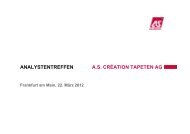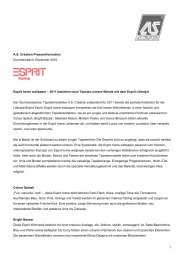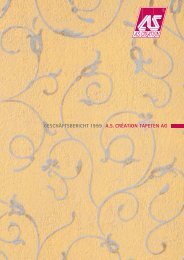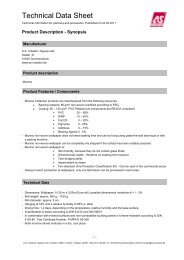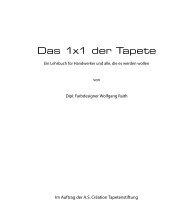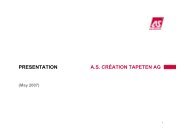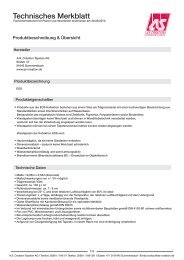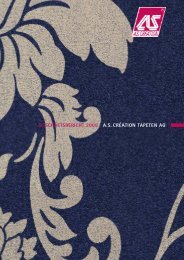ANNUAL REPORT 2011 A.S. CRÉATION TAPETEN AG
ANNUAL REPORT 2011 A.S. CRÉATION TAPETEN AG
ANNUAL REPORT 2011 A.S. CRÉATION TAPETEN AG
You also want an ePaper? Increase the reach of your titles
YUMPU automatically turns print PDFs into web optimized ePapers that Google loves.
In accordance with IAS 21, foreign currencies in the financial statements of consolidated<br />
companies in non-EMU countries are translated according to the functional currency concept<br />
using the modifi ed closing rate method. Under this method, changes in non-current assets are<br />
translated at average annual rates, equity is translated at historical rates and all other balance<br />
sheet items are translated at closing rates. Differences referring to non-current assets are shown<br />
in the development of the Group’s tangible and intangible fi xed assets schedule in the “Currency<br />
translation” line. All items in the income statement are translated at the average annual rate.<br />
Currency differences are not recognised in the income statement but are allocated to the<br />
currency translation differences within the equity.<br />
Translation differences from debt consolidation are recognised in the income statement.<br />
An average annual rate of £ 0.86787/€ (2010: £ 0.85796/€) and a closing rate of £ 0.83670/€<br />
(2010: £ 0.86250/€), were used for the pound sterling, while an average annual rate of<br />
RUB 40.88510/€ (2010: RUB 40.14295/€) and a 77 closing rate of RUB 41.68680/€ (2010:<br />
RUB 40.47460/€) were applied for the Russian rouble.<br />
Accounting and valuation principles<br />
Tangible fixed assets are reported at the cost of acquisition or production to be capitalised. In<br />
accordance with IAS 17, assets acquired under finance leases are shown at the lower of their<br />
current market value at the beginning of the lease or the present value of the minimum lease<br />
payments.<br />
With the exception of printing rollers and rotary screens, tangible fixed assets subject to depreciation<br />
are written off using the straight-line method. Depreciation is based on the following<br />
useful economic lives:<br />
Buildings 10 to 30 years<br />
High-bay warehouses 20 years<br />
Large machines 10 to 15 years<br />
Other machines 3 to 10 years<br />
Other plant, furniture and fixtures 3 to 10 years<br />
CONSOLIDATED FINANCIAL STATEMENTS ACCORDING TO IFRS<br />
83





